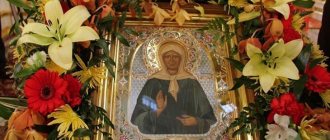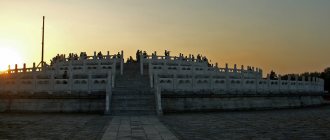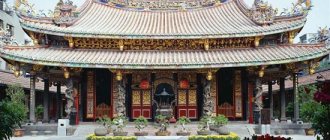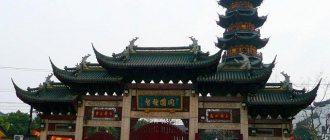The Trinity Lavra of Sergius is a visiting card, the main significant place of Sergiev Posad. It was she who gave rise to the formation of the city and became the pride of Russian Orthodoxy. From the moment of its foundation and in all subsequent times, this monastery has been and remains one of the main attractive spiritual and cultural centers. It is impossible to walk around, comprehend and evaluate all the buildings of the Lavra, and there are more than 50 of them, in one or two visits.
The monastery was always reconstructed, remodeled and updated. Life activity in it did not stop or freeze for a minute, and, probably, not a single building retained its original image. Several roads lead to the Lavra; the main gate is the Holy Gate with the Church of the Nativity of John the Baptist, built in the 17th century.
Every year, thousands of believers make a pilgrimage to the Trinity-Sergius Lavra to see the shrines of the monastery, get acquainted with its history and architecture, and take part in divine services.
Hotels near the Trinity-Sergius Lavra
Architecture and buildings of the Lavra
Since the monastery complex was formed over seven hundred years, its example can be used to trace the evolution of architectural traditions of different times. Entrance to the monastery is through the main gate. Above them rises the Red Gate Tower with loopholes. The gates are decorated with frescoes illustrating scenes from the life of Sergius of Radonezh.
The Church of the Nativity of John the Baptist is designed in the Moscow Baroque style and greatly decorates the entrance to the monastery courtyard. The cathedral in honor of St. Sergius of Radonezh is especially interesting in terms of architecture, since its construction dates back to 1422. The oldest building demonstrating the traditions of architecture of the 15th century.
The main temples of the Trinity-Sergius Lavra
In the courtyard of the monastery there are many churches built at different times. The gate temple of the late 17th century in honor of the Nativity of John the Baptist greets pilgrims at the entrance. Further on, the Spiritual Church and the Trinity Cathedral open up. The refectory temple in the Naryshkin Baroque style is located a little to the left and pleases the eye with its festive, bright appearance.
Cathedral of the Assumption of the Blessed Virgin Mary, Trinity Lavra of St. Sergius
The Assumption Cathedral makes an unforgettable impression. It was built in 1559-1585 and is the largest among all the Lavra churches. It was here that the relics of St. Sergius originally rested. The decoration of the cathedral was carried out by outstanding masters of that time - Simon Ushakov and Dmitry Grigoriev.
Interesting! After passing behind the Trinity Cathedral, you can see the tallest bell tower in the country.
Nearby there is an overhead chapel and a bowl with a cross under the canopy. The ensemble also includes the Church of the Smolensk Icon of the Virgin Mary. The temple was built in the Baroque style and amazes with its solemn beauty.
History of the Holy Trinity Sergius Lavra
The Holy Trinity Sergius Lavra owes its appearance to two brothers - Stephen and Bartholomew, born into a boyar family. From childhood, Bartholomew sought to serve God, however, his parents did not give him their blessing to do so. When mother and father, having grown old, decided to go to a monastery, the brothers were still able to leave worldly life.
Formation of the monastery
In 1337, not far from the city of Radonezh, on a hill in a wooded area, Stefan and Bartholomew built a cell and a small church with their own hands. The elder brother could not live in solitude for long, but Bartholomew humbly prayed and served God. Could a 23-year-old young man imagine that the place he chose for his hermit’s life would become the greatest Orthodox shrine? The abbot of one of the monasteries located nearby tonsured Bartholomew a monk under the name Sergius. Thus began the glorious life of Sergius of Radonezh, who in the future had a huge influence on the spiritual life of not only nearby villages and hamlets, but also throughout Rus'. Leading a hermit's life, Sergius learned humility - he worked on the land, prayed intensely and did not desire fame at all. However, fate decreed differently. His church began to attract more and more people who asked him to teach them how to lead a godly life. Other dwellings began to appear near Sergius’s cell. Gradually the area was populated by people who preached Orthodoxy. We can talk about the appearance of a monastery during this period of time, the exact date of its foundation is unknown (according to some sources it is 1337, according to others - 1342). At first, the abbot was the same monk who tonsured Bartholomew - Mitrofan. After his death, this place was taken by the Monk Sergius.
In 1355, some changes took place on the monastery land: it was divided into 3 zones: residential, economic and protective. A new Trinity Church was erected from wood; nearby there were residential buildings - cells and a refectory. The public area contained outbuildings and cultivated land. The territory of the monastery was surrounded by a fence; at the central gate there was a wooden church named after Dmitry of Thessaloniki. The general arrangement of structures on the territory has not undergone major changes. The popularity of the Trinity Monastery as the spiritual center of the Russian lands grew with unusual force. More and more Moscow princes sought blessings here. It is a known fact that Sergius of Radonezh provided enormous support to Dmitry Donskoy, blessing him before the Battle of Kulikovo. The Monk Sergius sent two monks with the army - Peresvet and Ooslablya, contrary to the strict monastic rules. In 1932, Sergius of Radonezh entered into eternal rest and was buried inside the main church. At that moment, one of his students Nikon was listed as abbot.
New life for the monastery
In 1408, disaster struck: Khan Edigei practically wiped the monastery off the face of the earth. But perhaps this marked the beginning of a new stage in the development of the monastery. In 1415, Abbot Nikon laid the foundation for the first building made of stone - the Trinity Cathedral. The construction was carried out by craftsmen from Kosovo, who have found shelter here for some time now. The painting inside the temple was carried out by famous masters of icon painting Andrei Rublev and Daniil Cherny. An interesting fact is that the famous “Trinity” icon was painted specifically to decorate the iconostasis of this cathedral.
In 1469, construction began on another stone building - the refectory. Its peculiarity was that it had the type of a single-pillar chamber; this technique subsequently began to be widely used in architecture. On the lower floor there were refectories for the brethren, and on the upper floor there were royal chambers. In 1476, another temple appeared near the cathedral. During the reign of Ivan the Terrible, who often visited the monastery, the territory was again modified. In particular, white stone walls were erected along the perimeter. Their length was almost one and a half kilometers. Thanks to the dams built and surrounded by high walls, the monastery turned into a real fortress. In the middle of the 16th century, the monastery received a new status - archimandria. Ivan the Terrible contributed to laying the first stone in the construction of the large Assumption Cathedral. However, five years later construction was stopped due to a fire, as a result of which many buildings were severely damaged. The Assumption Cathedral was nevertheless completed, but Ivan the Terrible was not destined to see the built temple; its illumination took place after the death of the sovereign in 1585. By the second half of the 16th century, there were no equals to the Trinity Monastery in the state: it administered almost 3,000 settlements, which not only fully provided themselves with everything they needed, but also carried out trade abroad.
Difficult times - 17th century
In 1608, the siege of the monastery by Polish-Lithuanian invaders began. But this was not the worst thing: a year later, inside the monastery, people began to die en masse from scurvy. But this, fortunately, did not become the reason for the seizure of land. An unknown force made it possible to defend the monastery. Help arrived in time: in the winter of 1610, an army led by Mikhail Skopin-Shuisky liberated the monastery. A few years later, the Trinity-Sergius Monastery was again attacked, this time the Polish prince Vladislav wanted to conquer it. But his dreams were also not destined to come true.
Prosperity of the monastery in the 17th-18th centuries
After the siege, restoration began at a rapid pace: the walls were significantly strengthened, the towers acquired the appearance that has survived to this day. New buildings appeared: a large bell tower, the Church of Mikhail Malein, royal mansions, and a little later - additional stone cells, a hospital complex and 2 more churches. Life flourished - the monastery's possessions began to exceed those of the royal and patriarchal. Under Peter I, a refectory and a church in honor of Sergius of Radonezh, as well as a gate church, appeared here. A little later, the monastery was fortified due to the unexpected possibility of capture by the Swedes. A ditch was dug and 2 stone bridges were built. The earthen fortifications still exist today. After Peter I, interest in the Trinity-Sergius Monastery faded; there was even an option to move it closer to St. Petersburg. However, in 1738 the Spiritual Council began to manage life here.
A new milestone in the development of the Lavra
With the advent of Elizabeth Petrovna to the throne, the next era of development begins. In 1742, a theological seminary was opened here, and in 1744 the monastery was given the title of Lavra, and the Metropolitan of Moscow became its head.
The Empress really loved visiting the Lavra; she contributed to the fact that almost all the buildings inside the monastery changed their appearance compared to the original. The bell tower appeared in 1770, for which a huge bell was cast, its weight was 4065 pounds. The Lavra continues to be the largest spiritual and cultural center; its role was further strengthened after the transfer of the Theological Academy here in 1814. If we exclude the fact that because of this it was necessary to violate the overall integrity of the architectural complex of the monastery buildings, then the Theological Academy made the Lavra an even more powerful means of shaping the spiritual heritage. The 18th - 19th centuries were a time of unprecedented prosperity for the Lavra. The wealth of the monastery increased every year. This was facilitated by the huge amount of land owned by him, peasant souls, as well as active trading activities. The Trinity Monastery was a real treasury: it was there that the relics of many saints were located, including Sergius of Radonezh, Nikon, Metropolitan Joseph, and others. Moreover, it was the walls of this temple that were decorated with the most famous creation of Andrei Rublev - the icon of the Holy Life-Giving Trinity.
Lavra during the Soviet period
At the beginning of the 20th century, a difficult time began that affected the entire monastic life. On one May day in 1920, parishioners were met here for the last time, after which the Lavra was closed and the Theological Academy was dissolved. During the years of Soviet power, many buildings were reconstructed and began to serve as commercial and residential buildings. Most of the ancient bells were melted down. In 1940, work began on establishing a state historical and art museum-reserve here; the authorities tried to completely change the territory; insufficient attention was paid to the preservation of shrines and objects of great value. After the Great Patriotic War, a school was opened here, and a year later the Assumption Cathedral was returned to the Patriarchate. In the post-war period, large-scale restoration work was carried out to give architectural objects a look as close as possible to the original.
Trinity-Sergius Lavra today
In 1993, the Trinity-Sergius Lavra was included in the list of UNESCO World Heritage Sites in Russia. Now the territory of the monastery includes many architectural monuments, the likes of which are not found anywhere else. The modern Lavra is a unique functioning monastery with approximately two hundred monks. Anyone can come to this amazing place - interesting excursions are held every day for pilgrims and tourists from all over the world.
Activities of the parish
Numerous excursions are organized at the Lavra. The brethren gladly accept help from volunteers and workers for the benefit of the monastery. There is a refectory at the monastery. A health center has been organized here, where hieromonk Moses and monk Meliton receive patients. The center sells medicinal herbal teas, which can also be purchased via the Internet.
Cathedral of the Icon of the Mother of God of the Chernigov-Gethsemane Trinity Lavra of Sergius
The work of the pilgrimage center is aimed at solving organizational issues related to the arrival of guests. It also conducts missionary work in orphanages, prisons and hospitals.
Help for the sick and possessed at the Lavra
People often come to the monastery who, according to doctors, are mentally ill. In the Orthodox community, such illnesses are called demon possession and corruption. In churches, the possessed person is reprimanded. For this purpose, special prayers are used, which have been known since the 4th century. During the ritual, some pretty creepy things happen. A person possessed by a demon makes strange sounds, his body wriggles in unnatural positions. It is not recommended for ordinary, inexperienced people to attend. There is a possibility of catching a demonic entity yourself.
Father German (Chesnokov) is considered the most experienced exorcist in the city. It is to him that those who are desperate to return to normal life try to get to because of their obsession.
Educational institutions on the territory of the monastery
In 1742, Elizaveta Petrovna ordered the opening of the first educational institution on the territory of the monastery. It became the Trinity Lavra Theological Seminary. The first experience turned out to be positive, because in subsequent decades and even centuries the monastery walls hosted students. Worthy of attention:
- Moscow Theological Academy (1814 - 1917);
- Schools of icon painting (1885 -1917);
- Moscow Theological Seminary (1989).
Note! In the first years of Soviet power, various schools were located on the territory of the monastery, which had nothing to do with students receiving spiritual education.
Shrines and patronal feasts
The most revered relic in the Holy Trinity Lavra is the relics of its founder, St. Sergius of Radonezh. Also here are the icons of the Mother of God - Tikhvin and Chernigov. Believers can venerate the relics of Saints Maxim the Greek and Anthony of Radonezh.
The revered icon of St. Nicholas, located in the Church of St. Sergius, is of value.
Important! The Day of the Holy Trinity and the Dormition of the Blessed Virgin Mary are celebrated with special reverence at the Lavra.
All Orthodox believers who visit the glorious city of Sergiev Posad are recommended to visit this holy place. Despite the crowds, there is peace and tranquility here, allowing you to concentrate and think about such important things as the soul and our purpose in this life.
Restoration of the Lavra
Immediately after the end of active hostilities in 1917-1918. In the area adjacent to the monastery, the Bolsheviks created a commission to protect the ancient valuables that were kept in the monastery, as well as organizations to carry out restoration work. But this work was carried out very poorly, since there was no single idea of what the new monastery should look like and why it was needed at all.
On a note! Systematic restoration work began only in 1938 after the young architect Ignatius Trofimov was invited to participate in it.
It took Trofimov two years to prepare a certificate about the museum and a project for restoration work. On February 1, 1940, the Lavra and the surrounding territory were declared the Zagorsk State Historical and Art Museum-Reserve. Trofimov was appointed chief architect, allocating 6 million rubles for restoration.
The war prevented its completion. But despite the hostilities and post-war devastation, the destruction of the monastery was avoided. Some of the monuments were restored, while others were built almost from scratch.
Restoring the Lavra is the primary and most important task that the government set before Trofimov. In 1950 Trofimov’s work was continued by his student, architect V.I. Baldin. In 1963, A.G. got involved in the case. Ustinov, who insisted on a comprehensive restoration of the Lavra ensemble. By the beginning of the 1970s. Most of the restoration work was completed, but the restoration of the monastery did not stop there.
The work of the first architects was continued by the younger generation. Many parts of the monastery can now be seen thanks to the work of architects Yu.D. Belyaeva and Yu.N. Shakhova.
In 1990-2000 The Lavra was restored to its original pre-revolutionary appearance, some walls were repainted, the previous painting was recreated, and the bell tower was repaired. In 2004, the Tsar Bell returned to the bell tower. It had to be cast again because the previous one was melted.
Important! In 1993, UNESCO included the Trinity-Sergius Monastery on the list of world cultural heritage.
Divine service in the monastery
Believers can come to the Lavra every day; the doors of the monastery are open from 5:00 to 21:00. On major holidays and days of memory of St. Sergius of Radonezh, the monastery operates around the clock. The schedule in the temples of the Lavra is different and can be clarified on the official website of the monastery.
Divine service in the Assumption Cathedral of the Trinity-Sergius Lavra
The tentative service schedule is as follows:
- in the Assumption Cathedral, the early Liturgy takes place at 6:45, and the late Liturgy at 9:30. Evening service is at 16:45. The all-night vigil begins at 17:00;
- in the Trinity Cathedral every morning from 5:30 to 6:30 a fraternal prayer service is held over the relics of St. Sergius and the Midnight Office. Middle Liturgy - at 6:30.
Abbots and governors
From 1344 to 1560 35 abbots were replaced, and from 1561 to 1766. 34 Archimandrite. The current governor, Thomas, is already 41 in the ranks of his predecessors. He is the vicar of the Patriarch of Moscow, formally considered the main monastery.
It is interesting that only 16 primates of the Russian Orthodox Church before the current Patriarch of Moscow headed the Lavra, among them are such famous ones as Metropolitan Philaret and Patriarch Tikhon, who entered into open confrontation with the Bolsheviks over the position of the Russian Orthodox Church in the state.
How Father German reprimands in Sergiev Posad - reviews from believers
The church rite of exorcism from the possessed is performed not far from Moscow on the territory of the monastery of the Holy Trinity St. Sergius Lavra. Archimandrite German (Chesnokov) carries out a mass lecture according to the most ancient canons.
Believers who attended the service talk about the strong impression they received from the ceremony. The feeling of belonging to the divine arises upon entering the gate temple and intensifies during the speech of the clergyman.
The reprimand is preceded by Father Herman's sermon, guiding the believers and penetrating deep into the soul. This is followed by an unusually long special prayer, accompanied by the unnatural muttering and howling of the possessed.
Ordinary people watch with fear how the unclean spirit manifests itself in those possessed by demons. Sprinkling with holy water causes disgusting convulsions in the possessed, animal sounds burst out of their mouths, and people take on terrible forms.
After visiting the lecture three times, believers notice noticeable changes in their daily lives. For some, the ceremony helped in their personal lives; for others, their loved ones were cured of addictions and became kinder and calmer.
From the following article you will learn about the life and work of Hieromonk Photius.











